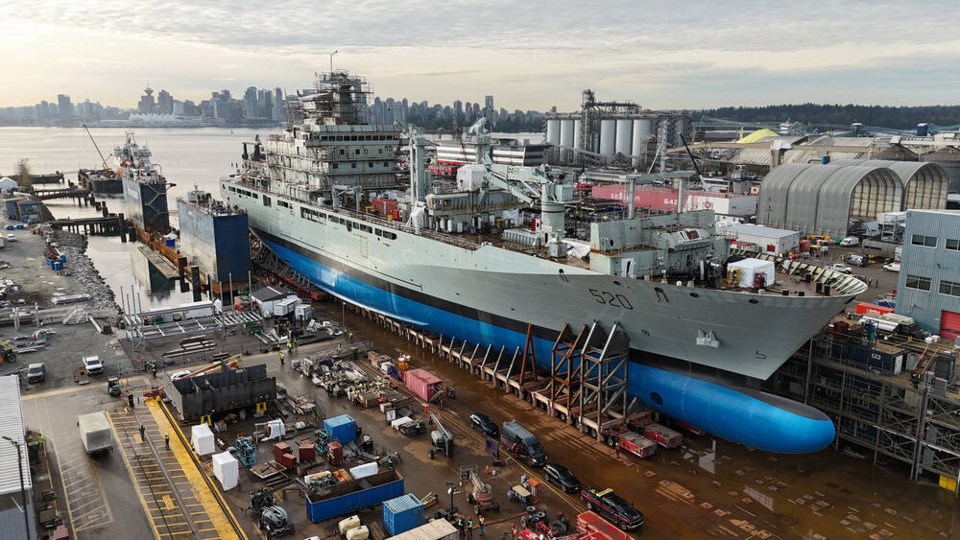The record for the highest property value on the North Shore has been smashed, according to the latest numbers from BC Assessment.
Seaspan’s Pemberton Avenue shipyard and head office was assessed at $313.2 million in 2024, up 31 per cent, or more than $100 million, from $211.8 million in 2023.
Seaspan’s adjacent parking lot, meanwhile, went from an assessed value of just $355,902 in 2023 to $24.4 million – a 6,866 per cent increase.
Reached for comment on the drastic change, a BC Assessment spokesperson said they could not speak publicly about the property’s most recent valuations.
“Out of respect for the formal property assessment appeal process and the need to maintain integrity of the process, BC Assessment cannot comment publicly on active appeals,” assessor Bryan Murao said.
For their part, a Seaspan representative said only “we are involved in the ongoing assessment process with BC Assessment on this matter.”
But District of North Vancouver staff, who have a long history in dealing with disputes over assessments on the industrial waterfront, were more candid. The lingering question of how much major industrial properties should be valued at for tax purposes has significant impacts on a municipality’s budget.
Between 2013 and 2019, Seaspan appealed every year’s assessment, arguing that the expected $100-million cost to carry out environmental remediation of the site should be reflected in the assessments with lower valuations.
The district took the shipbuilder to court and in 2022, the B.C. Court of Appeal sided with the district, sending the matter back to the Property Assessment Appeal Board for further consideration.
It’s likely that Seaspan will still seek a lower assessment at the appeal board, said David Stuart, District of North Vancouver CAO, though the court’s ruling should mean there won’t be much of a discount.
“We think at this point that within this year, we should have some closure on this, hopefully, and move on,” Stuart said.
Also likely dragging Seaspan’s assessment up was the 2024 sale of another waterfront industrial site. In April, hydrogen research and development firm HTEC purchased ERCO Worldwide’s Maplewood area chemical plant for $145 million – the largest industrial land transaction in the North Shore’s history. ERCO will continue to operate the plant while HTEC intends to retrofit the facility with infrastructure to capture 15-tonnes of byproduct hydrogen per day.
Apart from Seaspan, the highest valued non-residential properties on the North Shore include Chemtrade’s Amherst Avenue chemical plant at $263.1 million, the industrial property at 1371 McKeen Ave. at $175.2 million, Park Royal in West Vancouver at $169.7 million, the G3 grain terminal at the foot of Brooksbank Avenue at $161.6 million, and HTEC’s new plant on Forester Street at $130.6 million.
Ports Property Tax Act questioned
But even as clarity comes to the taxable value of the North Shore’s priciest property, Stuart warns assessments elsewhere on the industrial waterfront are getting even more out of whack, thanks to provincial legislation.
The 2004 Ports Property Tax Act gave the province the authority to artificially cap the assessed value of certain waterfront terminals including Fibreco, Western Stevedoring and Kinder Morgan.
In 2007, the uncapped properties, including Seaspan, Allied Shipbuilders, Chemtrade and ERCO Worldwide, were facing assessments that were twice as high as their industrial neighbours, but the disparity has grown drastically.
In 2025, the capped properties were being assessed at about $397,000 per acre while the uncapped properties were over $6 million per acre.
“We’ve got this very, very different approach to how the different properties are being treated,” Stuart said, adding that the other municipalities impacted by the act have joined the district in lobbying the province to reform the legislation to make it more equitable for all parties involved. “You can’t have one group of taxpayers paying 17 times the other group, just because the provincial government is in an awkward situation.”
The province is supposed to compensate municipalities directly for the lost revenues, but district chief financial officer Rick Danyluk said the provincial grants aren’t keeping up.
“The last analysis that we’ve done, I think on a combined basis, we’re somewhere between $20 and $30 million a year that’s not going to municipalities because of the Ports Property Tax Act,” Danyluk said.
The act was intended to lower the capped terminals’ tax burden and free up cash for the operators to invest in new capital projects on their lands. But Stuart said it hasn’t had the desired effect. Between 2007 and 2025, the capped properties did spend almost $83 million on new investments, but on a per-acre basis, the uncapped properties outspent them by a ratio of 2 to 1.
“A limited number of municipalities are asked to suck it up to try to incentivize investment. It doesn’t do that, and it just becomes a burden,” Stuart said.
Commercial and light-industrial lands
In the District of North Vancouver, light-industrial properties saw their assessments up by 5.7 per cent in 2024, on average, while commercial lands saw a more modest 1.4 per cent growth.
In the City of North Vancouver, light-industrial lands actually went down by two per cent, while commercial properties rose 1.4 per cent.
The District of West Vancouver has no land with light-industrial zoning, but assessments on commercial properties went up 3.6 per cent.




